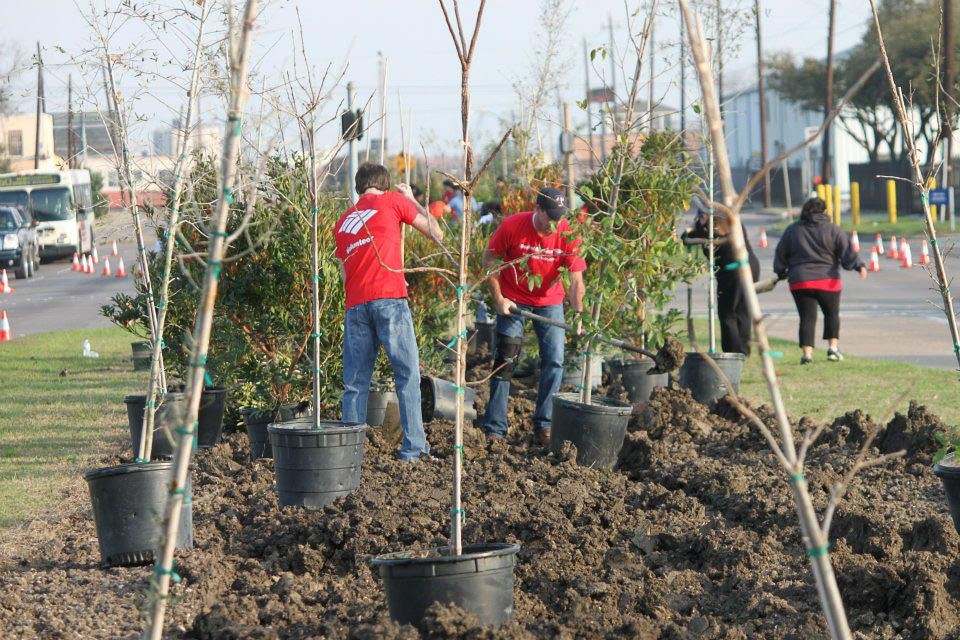Leah Binkovitz | @leahbink | May 12, 2016
 Volunteers plant trees in Houston's East End in 2013. Image via Greater East End Management District.
Volunteers plant trees in Houston's East End in 2013. Image via Greater East End Management District.As a kid in the 1980s, Bolivar Fraga remembers the Waco Street bridge across Interstate 10 as a dividing line. Latinos lived to the south, in the Second Ward. Blacks lived to the north, in the Fifth Ward. Fraga lived in Second Ward. If you rode your bike across the bridge, he said, “you were taking a risk.”
Now the two neighborhoods, both experiencing redevelopment, are looking to work together after decades of division. In many ways, the overlap of the neighborhoods has already happened. The Fifth Ward, settled by freedmen, was once 95 percent black. Today, blacks are only slightly more than half the area's population, as the number of Hispanic residents and recent immigrants has grown. But, community development organizers say, there’s still a lot of work to do to actually connect the communities.
“It’s very territorial,” said Kathy Flanagan Payton, president of the Fifth Ward Community Redevelopment Corporation. Her group, along with the Greater East End Management District in the Second Ward, the Houston-Galveston Area Council and the Buffalo Bayou Partnership, was part of a Livable Centers Plan for the area completed last year. Now, community development groups are facing a lengthy set of recommendations, including everything from better access to healthy food to the renovation of a historic cemetery.
But first, they have to figure out how to bring the neighborhoods together. That was part of the mission Wednesday, as community leaders met with fellows from across the country as part of Next City’s 2016 Vanguard conference to learn more about the best ways to foster collaboration.
“The publicity is that Houston is always evolving,” explained Diane Schenke, president of the Greater East End Management District, but, “in these historic neighborhoods, there’s a very strong sense of place.”
Both Schenke's group and Payton's group have worked on projects that try to capture that sense of place. In the East End, the renovated Esplanade on Navigation Boulevard grew out of the annual feast of Our Lady of Guadalupe that would spill out into the street and is hosted by the historic church that has anchored the neighborhood for more than 100 years. In the Fifth Ward, meanwhile, the area is enjoying the recent renovation and reopening of the DeLuxe Theater, thanks to a partnership with Texas Southern University. That one meant a lot to Payton, whose mother used to sell tickets at the venue.
“We have so many similar problems,” said Schenke, who said both communities have dealt with vacant lots, relative lack of healthy food access and limited connectivity to the area's bayou. For many residents of both neighborhoods, the tendency has long been to head to the southwest side of town or other areas for entertainment and shopping options. “We don’t tend to think of ourselves as close as we are,” she said. It’s been hard to, for example, leverage community organizing to attract more grocery stores. “If we start combining two neighborhoods that are redeveloping and thriving, it’s a much different picture.”
Part of the challenge has been defending each neighborhood's individual sense of identity. Gloria Moreno, a former president of the Second Ward Super Neighborhood, remembers a fight to get “Second Ward” put on Metro station signage when the new light-rail came in. Fraga, who just ended his term as Second Ward’s Super Neighborhood president, said while he’s happy the area east of downtown marketed as EaDo is flourishing, he doesn’t want to see the new neighborhood brand creep into Second Ward. “I don’t want to be branded as EaDo,” he said. “You cannot just erase us,” Moreno added.
Payton said she’s similarly struggled with creating a positive perception of the Fifth Ward that would draw upon its history as a once thriving center of black life and culture.
As attitudes shift and development money flows in, community organizers have to contend with another perception problem: that of long-term residents concerned about gentrification. “People do worry,” said Patrick Ezzell, director of economic development for the East End Management District, “even about new sidewalks.” Property values have steadily risen in the East End. Home prices there shot up 85 percent from 2010 to 2014, according research from Rice University’s Shell Center for Sustainability.
But local officials say there's little a management district can do when it comes to housing affordability, other than working with private developers. That’s where a community development corporation fits in. So while the East End management district has put in 32 miles of new sidewalks and created a connection to Buffalo Bayou along Milby Street, in the Fifth Ward the CRC has built hundreds of affordable single-family homes, and housing remains a large focus for the group.
“We’re not trying to impede development but manage it,” said Harvey Clemons, Jr., pastor at Pleasant Hill Baptist Church and board member of the Fifth Ward CRC.
Some of the projects in the Livable Centers study are already in the works. The Fifth Ward tax increment reinvestment zone was expanded, sidewalks were put in to connect Harrisburg Boulevard to the bayou, and the Buffalo Bayou Partnership is seeking to expand Japhet Creek Park. But other goals, like establishing a community land trust to preserve long-term affordability, will take time.
“The biggest asset we have is our ability to dream together,” Clemons said.

